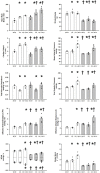Ventricular-Vascular Uncoupling in Heart Failure: Effects of Arterial Baroreflex-Induced Sympathoexcitation at Rest and During Exercise
- PMID: 35450162
- PMCID: PMC9016757
- DOI: 10.3389/fphys.2022.835951
Ventricular-Vascular Uncoupling in Heart Failure: Effects of Arterial Baroreflex-Induced Sympathoexcitation at Rest and During Exercise
Abstract
Autonomic alterations in blood pressure are primarily a result of arterial baroreflex modulation of systemic vascular resistance and cardiac output on a beat-by-beat basis. The combined central and peripheral control by the baroreflex likely acts to maintain efficient energy transfer from the heart to the systemic vasculature; termed ventricular-vascular coupling. This level of control is maintained whether at rest or during exercise in healthy subjects. During heart failure, the ventricular-vascular relationship is uncoupled and baroreflex dysfunction is apparent. We investigated if baroreflex dysfunction in heart failure exacerbated ventricular-vascular uncoupling at rest, and during exercise in response to baroreceptor unloading by performing bilateral carotid occlusions in chronically instrumented conscious canines. We observed in healthy subjects that baroreceptor unloading caused significant increases in effective arterial elastance (Ea) at rest (1.2 ± 0.3 mmHg/ml) and during exercise (1.3 ± 0.2 mmHg/ml) that coincided with significant increases in stroke work (SW) (1.5 ± 0.2 mmHg/ml) and (1.6 ± 0.2 mmHg/ml) suggesting maintained ventricular-vascular coupling. Heart Failure significantly increased the effect of baroreceptor unloading on Ea at rest (3.1 ± 0.7 mmHg/ml) and during exercise (2.3 ± 0.5 mmHg/ml) whereas no significant increases in stroke work occurred, thus signifying further ventricular-vascular uncoupling. We believe that the enhanced ventricular-vascular uncoupling observed during baroreceptor unloading only worsens the already challenged orthostatic and exercise tolerance and thereby contributes to poor exercise performance and quality of life for heart failure patients.
Keywords: arterial baroreflex; baroreceptor unloading; orthostatic hypotension; orthostatic intolerance; ventricular-vascular coupling (VVC).
Copyright © 2022 Mannozzi, Al-Hassan, Kaur, Lessanework, Alvarez, Massoud, Bhatti and O’Leary.
Conflict of interest statement
The authors declare that the research was conducted in the absence of any commercial or financial relationships that could be construed as a potential conflict of interest.
Figures




References
-
- Ansorge E. J., Augustyniak R. A., Perinot M. L., Hammond R. L., Kim J.-K., Sala-Mercado J. A., et al. (2005). Altered Muscle Metaboreflex Control of Coronary Blood Flow and Ventricular Function in Heart Failure. Am. J. Physiology-Heart Circulatory Physiol. 288, H1381–H1388. 10.1152/ajpheart.00985.2004 - DOI - PubMed
-
- Augustyniak R. A., Ansorge E. J., Kim J. K., Sala-Mercado J. A., Hammond R. L., Rossi N. F., et al. (2006). Cardiovascular Responses to Exercise and Muscle Metaboreflex Activation during the Recovery from Pacing-Induced Heart Failure. J. Appl. Physiol. 101, 14–22. 10.1152/japplphysiol.00072.2006 - DOI - PubMed
Grants and funding
LinkOut - more resources
Full Text Sources

